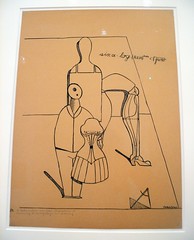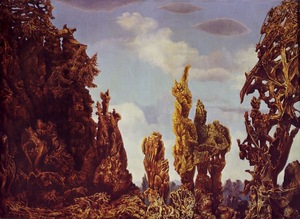January 15, 2009
Unlawful spaces of identity
 I went to the Max Ernst exhibition at the Stockholm Museum of Modern Art, where I saw this nice dadaist formula for competition. So now we know that the square root of Juno is larger than the sine of the corset angles times the logarithm of R&H to the power of dada.
I went to the Max Ernst exhibition at the Stockholm Museum of Modern Art, where I saw this nice dadaist formula for competition. So now we know that the square root of Juno is larger than the sine of the corset angles times the logarithm of R&H to the power of dada.
I quite like Max Ernst's decalomania works from the 40's. Giornale Neuvo has a nice post about it, including the heart-warming episode of how it helped him escape France during the war.
To me these paintings have always seemed wonderfully Lovecraftian. This is Rlyeh in tropical sunshine, with the baroque coral architecture of the Great Old Ones clearly visible. I wonder why some find it uncanny. Maybe it is because it is so unlike human objects, but we generally do not find fractal nature uncanny.
While I enjoyed the decalomania the most, it was also interesting to see the sheer range of styles Ernst had gone through. From dada to classic surrealism, to collages to abstraction. As well as Kermit-like sculptures and the Codex Seraphinianus-like work "Maximiliana: The illegal practice of astronomy" written in an invented alphabet.
This links the exhibition in my mind to Philip Palmer's space opera Debatable Space. While the main plot deals with a group of space pirates attempt to unseat the evil dictator of humanity (as you can guess, almost all reviews include the word 'swashbuckling'), the truly interesting part is the recollections of one of the characters, Lena. She happens to be the oldest living human. She was born in the late 20th century and lucky and driven enough to get the right rejuvenation methods. Her story, told from her rather conceited viewpoint, is in my opinion the redeeming feature of an otherwise pretty simple story with standard plots, caricature evil and Xanathos roulettes.
What I find interesting with Lena's story is the serious attempt at sketching just how varied an extremely long life would be. From Oxford academic to crime-fighter to self-help guru to dominatrix to failed actress to NGO manager to relief worker to politician to criminal to archivist to nobility to space loner to pirate... The many lives of Lena suggest that a sufficiently long life might be equivalent to many lives. Except that there might be a few more or less random things ending up being the personal core. Maybe there isn't so much a self as a persistent style - but this style might again be expressed in many different ways.
We will hopefully see in the future just how much we change across life. My guess is that a merely unageing human would get stuck in a certain personality and style rather easily. But true longevity is going to require adaptation and change on a deep level, and this might force us to change more (keeping the brain's learning rate and hence changing rate from declining seems to be necessary, for example). The question is whether indefinite survival requires so much change that identity is not preserved. In a cultural setting change comes from coevolution with other ("culture" in its broadest sense) people and technological change. Since culture cannot be arbitrarily divergent since it is tied to inter-person relations, I don't think culture is going to be the main threat to identity. But technological shifts (like updating to a postbiological state) might be more threatening to identity. But maybe that is just because we are not used to them happening all the time.
Posted by Anders3 at January 15, 2009 02:33 PM